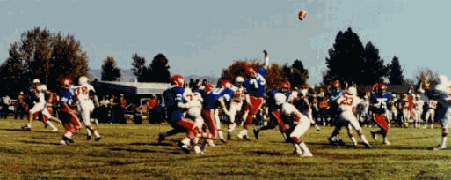|
than performance.
HONESTY. To be truthful in thought and action.
Don't lie to your team, or put a false face on the facts, for any reason. To do so is unfair to the team, because they have to know the truth in order to have a chance at success.
An example of what often happens in coaching is when a coach knows his team has a poor chance of winning an upcoming game. He glosses over the truth so that his team will enter the game with a good outlook. The coach hopes that his team's high expectations will be enough to carry them through the game successfully. This type of ploy sometimes works, but usually leaves the team unprepared for a difficult game.
Of all the qualities of leadership, honesty is probably the most important. If you are honest with yourself, as well as the team, your players will never have reason to doubt your word. Though the truth may sometimes hurt it can never deceive.
As you can see, to be a leader demands much of you, but is not a thing you should fear. Leadership has it's rewards as well as it's demands. The satisfaction of coaching a successful team is more than enough to make your efforts worthwhile.
EFFECTIVE TRAINING.
There are six types of training a football coach has to incorporate into his program. These are: physical conditioning, physical agility's, fundamentals, squad, team, and individual positional training.
You will find while designing your training program, that your team's actual practice time is so short You may find yourself hard pressed to accomplish all you would like to on any given day. It is therefore necessary to streamline your training by using methods that will train multiple areas simultaneously. Don't waste time with old fashioned rituals, your time is too valuable for that.
In this section I will explain the purpose of each of the six types of training and how to make your training program more efficient.
PHYSICAL CONDITIONING. The Purpose of physical training is simply to get, and keep, your players in shape to play football.
If your players are not in good physical condition, they will not be functional team members. They will also be prone to injury. Your players must be in shape.
Physical conditioning is probably the least enjoyable part of practice for the coach as well as the players. Conditioning is slow, uninspiring, and painful. Your players will hate it, so do your best to keep them motivated.
Calisthenics and stretching must always be done before conditioning. So you should start all your practices with calisthenics. If the weather is cool make sure that your players are stretched out before any strenuous activity. Don't let your inactive players go into scrimmage or games without first stretching.
Set the level of conditioning your players are subjected to according to the physical level they currently possess. If you over do your conditioning you are inviting injuries.
All practices should end with light activity such as slow jogging. The light activity lets your players cool down slowly, and reduces the chance of shock injuries. Strenuous physical activity, such as wind sprints, at the end of practice, is not good for your players. It denies them a slow cool down period.
AGILITY TRAINING. Agility training increases flexibility, builds coordination, increases speed and decreases reaction time. Agility's heighten player function and decrease injuries.
Agility's are any repetitive drill designed to train your players in fluid transitional
|
|

